LSDj Wave Synth Deep Dive Part 1
Оригинальная статья на chiptuneswin.com
Привет, я Defense Mechanism! Добро пожаловать в первый выпуск Intense Tech, где мы будет подробно рассматривать особенности LSDJ, в духе Paul’s LSDJ Tech Talk. Моя цель - передать знания и мудрость следующему поколению чипмузыкантов, создав тем самым армию блипающих мастеров!
В этом первом уроке вы получите понимание синтезатора WAV-канала! В частности, работу таких параметров, как Signal, Filter, Volume, Q и Cutoff.
Синтезатор WAV-канала является одной из самых запутанных и, возможно, пугающих фишек LSDJ. Надеюсь, что после прохождения этого и следующего упражнений вы не только обнаружите, что им легко пользоваться, но и приобретёте чёткое представление, как он работает, поймёте, что это одна из самых мощных сторон LSDJ!
Я подробно рассмотрю каждый параметр, чтобы демистифицировать то, что на самом деле происходит. Но давайте сначала начнём с краткого обзора самого WAV-канала.
WAV-канал воспроизводит 4-битную волну из 32 точек, что может быть представлено 32 цифрами в 16-ричном формате 0-F, как видно на скриншоте ниже
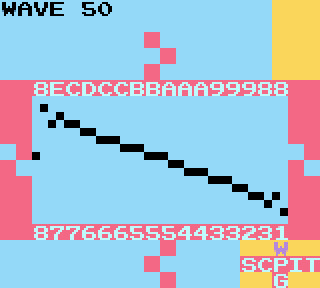
Для нас это означает, что каждая точка может иметь значение только от 0 до 15 (от 0 до F в 16-ричном формате). В то время как распространённый сегодня 16-битный звук допускает 65 536 уровней громкости, 4-битная глубина геймбоя допускает всего 16! Может показаться, что этого мало, но этого хватает, и это придаёт WAV-каналу характерный скрипучий звук.
Давайте начнем с рассмотрения основных форм звуковых сигналов, показанных на этом рисунке из Википедии:

К концу этого урока вы поймете, как создать синусоидальную волну, но прежде я должен дать некоторую теорию, как создается музыкальная нота.
Звук создаётся вибрирующим воздухом. Каждая форма волна, представленная выше, показывает, как выглядели бы эти вибрации, если бы мы могли их видеть. Можно представить их себе, вообразив как динамик ходит туда-сюда при воспроизведении звука.
Синусоидальная волна - основная форма волны, содержит чистую основную частоту основной ноты. Другие же формы волн содержать другие обертоны (кратные основной частоте). Комбинируя разные обертоны в разных соотношениях, мы можем создавать сигналы с разным звучанием (это называется изменением тембра самого звука). Вы слышите разницу в тембре между нотой, сыгранной на скрипке, и нотой, сыгранной на флейте, и это разница является результатом смешения разных обертонов, которые воспроизводятся в вибрирующем воздухе.
Для примера обертона, если вы умножите частоту на 2, то получите ту же высоту звука, но на 1 октаву выше. При увелинии ещё на 1, вы создаёте следующий обертон.
Пример: A 220 Гц (LSDj A3) - фундаментальная, она же корневая нота
Наименования нот даны для версии LSDJ 6+, в версии 4 нужно добавить 1 октаву
A 220 Гц x 2 = 440 Гц (LSDj A4) - на 1 октаву выше (1-й обертон)
A 220 Гц x 3 = E 660 Гц (LSDj E4) - 1 октава + 1 5-я (2-й обертон)
A 220 Гц x 4 = A 880 Гц (LSDj A5) - на 2 октавы выше (3-й обертон)
A 220 Гц x 5 = C # 1100 Гц (LSDj C # 5) - 2 октавы + 1 major 3rd (4-й обертон)
A 220 Гц x 6 = E 1320 Гц (LSDj E5) - 2 октавы + 1 5-я (6-й обертон)
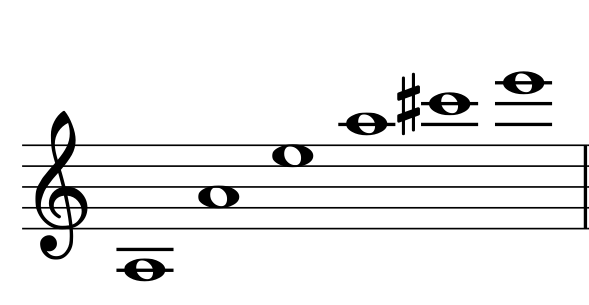
Первые 6 нот в гармоническом ряду А 220 Гц
Гармонический ряд ноты включает в себя корневую ноту и ноты, полученные умножением основной частоты на 2, 3, 4 и т.д.
Каждый множитель, кратный 2, представляет октаву основной частоту.
Каждый множитель, кратный 3, представляет одну 5-ю выше основной частоты (кроме множителя 9 и его кратных, которые представляют major 10th)
Каждый множитель, кратный 5, представляет собой major 3rd над основной частотой.
Некоторые нечётный множители не соответствуют традиционным нотам. Так, множитель 7 - это не-в-тон minor 7th, а 11 - flat 5th.
По умолчанию в LSDJ установлена пилообразная пила, которая создаются, когда синусоидальные волны всех нот в гармоническом ряду объединяются вместе.

Один полный цикл пилообразной волны, генерируемой в Audacity

Один полный цикл пилообразной волны, генерируемой в LSDJ
Давайте послушаем аудиопример, где сначала идёт пила из Audacity, а потом из LSDJ.
Сравнение волн
Небольшая разница есть, но в целом LSDJ-версия звучит высококачественно.
На экране синтезатора пила представлена как ![]()
Квадратная волна ![]() строится путем объединения синусоидальных колебаний гармонического ряда нечетных обертонов. Большинству из нас, вероятно, знаком чёткий писк прямоугольной волны, который получается в импульсных каналах, настроенных с рабочим циклом 50%.
строится путем объединения синусоидальных колебаний гармонического ряда нечетных обертонов. Большинству из нас, вероятно, знаком чёткий писк прямоугольной волны, который получается в импульсных каналах, настроенных с рабочим циклом 50%.
Треугольная волна ![]() строится так же, как и квадратная, используя только нечетные гармоники, но чем тише они становятся, тем они становятся выше. Треугольная волна хорошо подходит для очень глубоких басов. Возможно, вы её знаете по треугольному каналу приставки NES.
строится так же, как и квадратная, используя только нечетные гармоники, но чем тише они становятся, тем они становятся выше. Треугольная волна хорошо подходит для очень глубоких басов. Возможно, вы её знаете по треугольному каналу приставки NES.
It may not seem possible to create a sine wave in LSDj given that the “Signal” parameter has only these 3 options, and Sine is conspicuously absent. However, because each of these waveforms is fundamentally constructed from sine waves, I can show you how to extract a sine wave from any of these options.
Conveniently, the next parameter in the Synth screen, “Filter”, is just the tool we need.
With “Filter”, we have 4 options: Lowpass (Lowp), Highpass (Highp), Bandpass (Bandp), and Allpass (Allp).
If you’re familiar with a traditional filter on an analog synth or digital plugin you might understand these. If not, you can think of the filter in LSDj as allowing you to choose which harmonics in the sound you would like to produce in your resulting waveform. The frequency that the filter acts on is selected by the “Cutoff” parameter.
With Lowpass, only the low harmonics of the Cutoff and below will “pass through” the filter, meaning your fundamental frequency is the lowest tone, but you can expand to include up to the highest harmonics (in LSDj that’s up to 15 overtones, in theory). With Highpass, only the highest harmonics of the Cutoff and above will pass through, but you can expand to the lowest. With Bandpass, only the range of harmonics specified by Cutoff will pass through. And with Allpass, all harmonics will pass through, but the phases of some harmonics will be shifted where the Cutoff is emphasized, which produces different timbres as a result.
That dry explanation aside, next let’s take a look at what happens when we set our lowpass filter cutoff to 10. Since this is 0x10 (16 in hexadecimal) out of a possible 0xFF (255 in hexidecimal), we’ve set our filter to allow only the lowest note in the harmonic series, the fundamental. Remember that if you want to hear only the first waveform of the synth, set Play to Manual in the Wave Instrument screen.

Появляется дикая синусоида!
We can see that it looks a little bit squashed, so let’s increase the Q, also known as resonance. This parameter will give us a boost in the volume wherever our filter cutoff is set, while leaving the rest of the harmonics at the same volume. Let’s set Q to 1 to boost the volume of the fundamental only and see what we end up with:
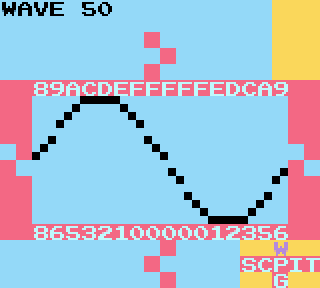
It’s somewhere in between a sine and a squashed triangle. Let’s lower the Volume to 08 and raise Q to 3. The Volume parameter adjusts the overall volume of the Signal before the Filter and Q are applied.
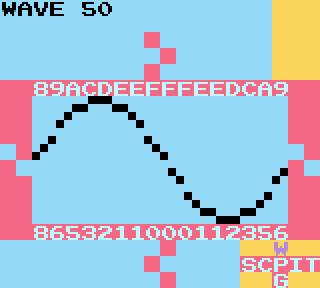
That’s looking pretty close to a sine wave, I’d say! Feel free to experiment with different Q, Cutoff, and Volume values and adjust them to your liking.
Playing notes at low octaves with this waveform creates the lowest, bassiest possible sound you can get in the Wave channel. It contains the fewest overtones possible, making it perfectly suitable for a low kick or sub-bass. In a perfectly ideal situation, a sine wave contains no overtones at all, only the fundamental frequency. However, because the wave channel bit depth only gives us 16 volume values, we can only roughly approximate a sine wave, and as a result some additional overtones creep into the sound.
Finally to wrap up the lesson, I want to show that every multiple of 10 of the “Cutoff” actually represents 1 overtone of the harmonic series. This becomes even clearer when we change “Lowpass” to “Bandpass” and raise our Volume to 20. Notice that if you set the Cutoff to 20, you’ll hear the overtone 1 octave above. If you set the Cutoff to 30, you’ll hear the overtone 1 octave + one 5th above. If you set Cutoff to 40, you’ll hear the overtone 2 octaves above, and so on. As you raise your filter cutoff, you can experiment with increasing the Q value to further emphasize the overtone you’ve selected – the higher your filter cutoff, the lower in volume the resulting overtone will be (this is a natural feature of how a sawtooth wave is produced).

And remember if you change your waveform to square or triangle, there are fewer overtones in those waveforms, so it may seem as if some of the octaves or other overtones are missing!
Cutoff at 20:
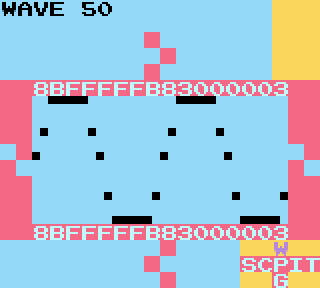
Шаблон:Audio:http://chipwiki.ru/music/intensetechwithdefencemech/cutoff20.mp3
Cutoff at 30:

Шаблон:Audio:http://chipwiki.ru/music/intensetechwithdefencemech/cutoff30.mp3
Cutoff at 40:
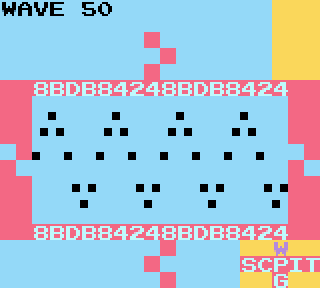
Шаблон:Audio:http://chipwiki.ru/music/intensetechwithdefencemech/cutoff40.mp3
Are you seeing any pattern in the resulting waveforms as we increase filter cutoff? Keep your observations in mind, as we’ll use them in the next installment!
Thanks for reading! I hope you enjoyed the tutorial and I’ll see you next time, where we’ll cover the remaining components of the Wave channel Synth!
DEFENSE MECHANISM, signing off!
LSDj Wave Synth Deep Dive Part 2
Оригинальная статья на chiptuneswin.com
Don’t Sleep on Z
Оригинальная статья на chiptuneswin.com
